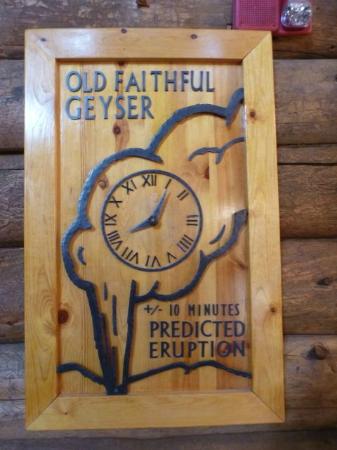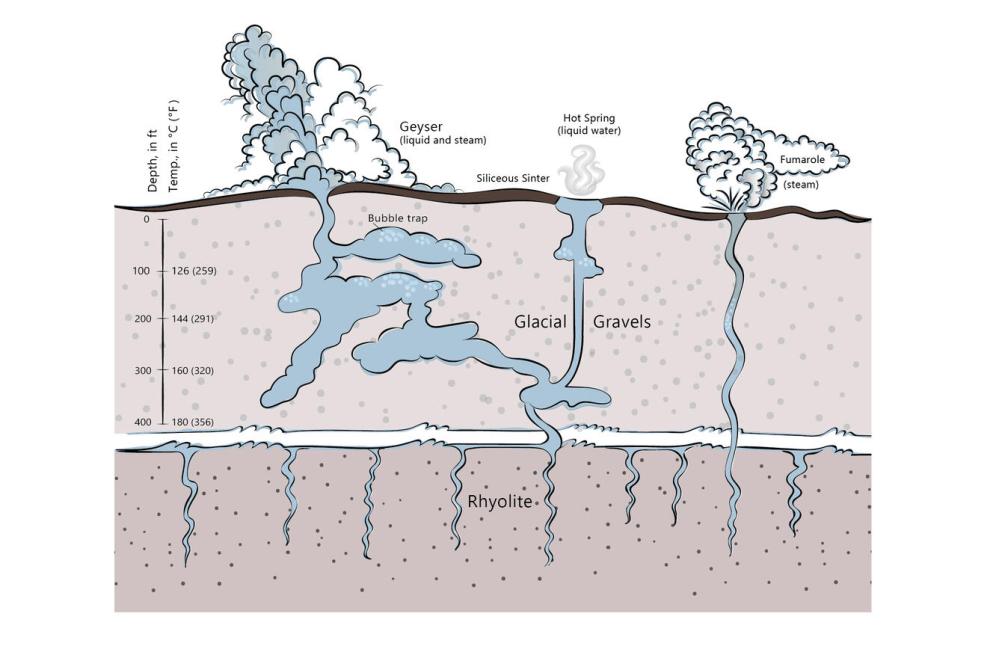Why Is Old Faithful So…Faithful?

By YW Naturalist Laura L.
Old Faithful is not the tallest geyser in the world. It’s not the most frequent. It may not even be the most exciting. And yet, it’s undeniably the most famous. Why?
The answer can be found in a combination of factors working in sync to create its signature “faithfulness”. For generations, Old Faithful has stood true to its name, reliably offering visitors a chance to witness one of nature’s most dramatic displays—a geyser eruption, or what geologists call “play.” It’s not just a plume of water—it’s a perfect recipe of heat, water, and underground “plumbing” coming together to entice visitors to discover what lies beneath.
Old Faithful was the first documented geyser to receive a name in what would later become Yellowstone National Park. During the Washburn-Langford-Doane expedition of 1870, a group of explorers mapping the rugged wilderness—scaling peaks, traversing meadows, fording rivers, and navigating massive canyons—arrived at the Upper Geyser Basin just as Old Faithful sent a plume of water over 100’ in the air. During their one and half day stay, this geyser erupted roughly every 74 minutes—a pattern so consistent, they couldn’t help but take note.
Photographer William Henry Jackson captures this late-1800’s eruption of Old Faithful. Jackson was a member of the 1871 Hayden expedition, along to document the truth for easterners skeptical to believe the “tales” they were hearing from the Washburn-Langford-Doane expedtion of 1870. William Henry Jackson f geyser photocrom print, 1898, Library of Congress
That reliability has become Old Faithful’s signature. Although the interval between eruptions has lengthened since Idaho’s 1983 Borah Peak earthquake—now averaging around 90 minutes—the geyser’s predictability has endured.
What makes Old Faithful so reliable? The secret lies deep underground.
Geysers are rare geologic features. Scientists estimate there are only about 1,000 geysers worldwide, and Yellowstone alone is home to roughly 500 of them—more than anywhere else on Earth. These geothermal features only occur under very specific conditions, where volcanic heat, abundant groundwater, and the right subsurface geology (fissures or cracks in the rock creating a “plumbing” system) align. Yellowstone’s magma chambers provide the perfect catalyst. Water filters down through fractured rhyolitic rock and is heated by magma chambers below causing it to rise up through the “pipes”, building pressure as it gets hotter and hotter, until it flashes to steam and explodes upward.

This diagram illustrates the complexities of a thermal area’s “plumbing” system. Note how the geyser and hots spring are sharing the same underground water source. Geysers that have a common water supply with other features are generally less predictable than those with an independent water source.
This diagram illustrates the complexities of a thermal areas “plumbing” system. Note how many surface features are sharing the underground water source. Old Faithful specifically, however, is in a class of its own: unlike nearly every thermal feature in the park, it has been mapped. In the 1990s, a specially equipped camera was lowered into the geyser’s vent, revealing a telling internal structure. Its narrow shaft and self-contained cavern, estimated to be the size of a small car, create an isolated “plumbing system.” Because Old Faithful doesn’t share heat or water with other nearby geothermal features, it builds and releases pressure on its own schedule. Researchers described the turbulent, boiling conditions deep within it as resembling a “liquid tornado.”

Notice how Old Faithful’s “plumbing”, is independent of any other surface vents. This is thought to help explain it’s “faithfulness”. This schematic was captured using small cameras lowered down the vent between eruptions.
Yellowstone’s other geysers range from mysterious to completely erratic. Some are dormant for decades, others unpredictable from one day to the next. But Old Faithful has erupted more than a million times in recorded history—and counting. Its independence and internal consistency allow scientists to continue predicting its plays with striking accuracy.
In a world that’s anything but predictable, Old Faithful is a rare constant. It’s the symbol of Yellowstone, reminding us that even amidst geological chaos, there can be order. That even in changing times, there can be predictability found in the natural rhythms of this reliable icon.
So no, Old Faithful isn’t the tallest, most powerful, or flashiest geyser in Yellowstone. But it is faithful. And that fact has been bringing visitors to relish in the entirety of Yellowstone’s wild beauty for over 150 years.
Old Faithful is the geyser that welcomes generations of travelers with the promise of awe. It’s the geyser that plays on more or less on “time”, delivering one of nature’s most fascinating geologic stories, again and again. In a landscape shaped by deep time and dynamic forces, Old Faithful offers something profound: a moment we can count on.
And that, perhaps more than anything else, is what makes it worth the wait.
You can learn more about booking your own adventure to experience Old Faithful, and countless other geyser and thermal features, with one of long-time local Naturalists HERE!
Blog by YW Lead Naturalist Laura L. To learn more about Laura, and the rest of the Yellowstone Wild Team, visit our About Us page!



